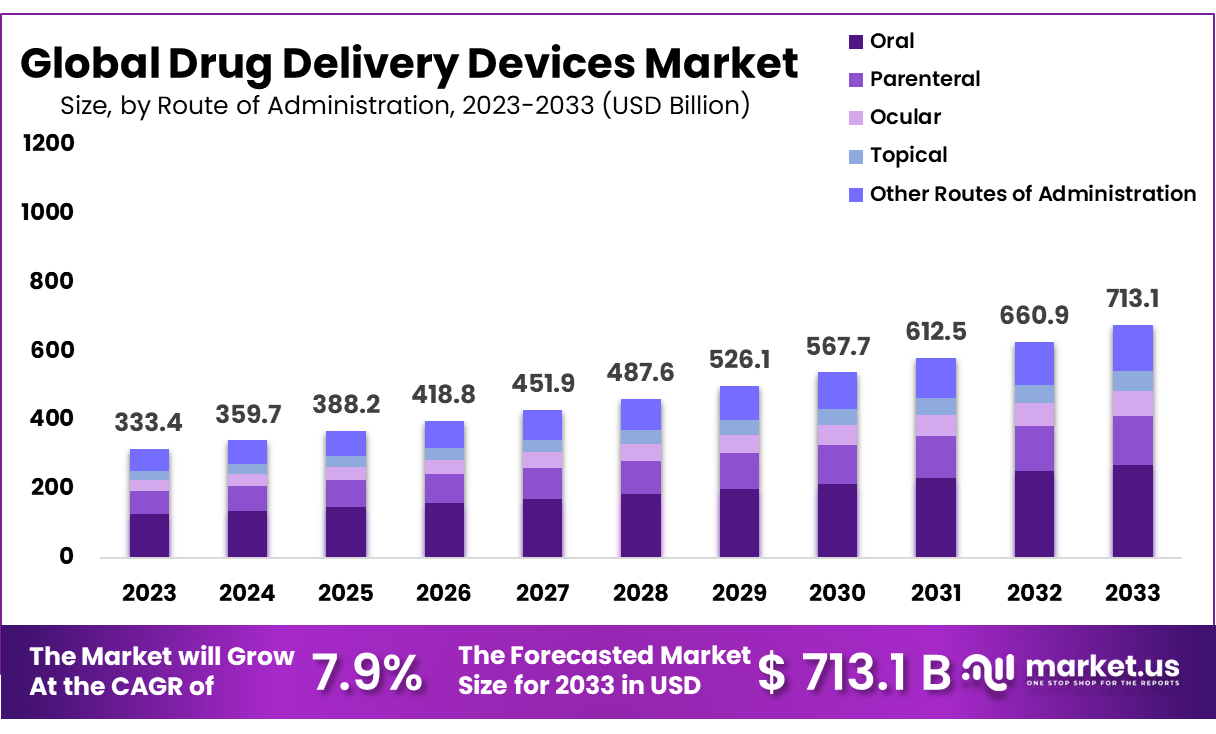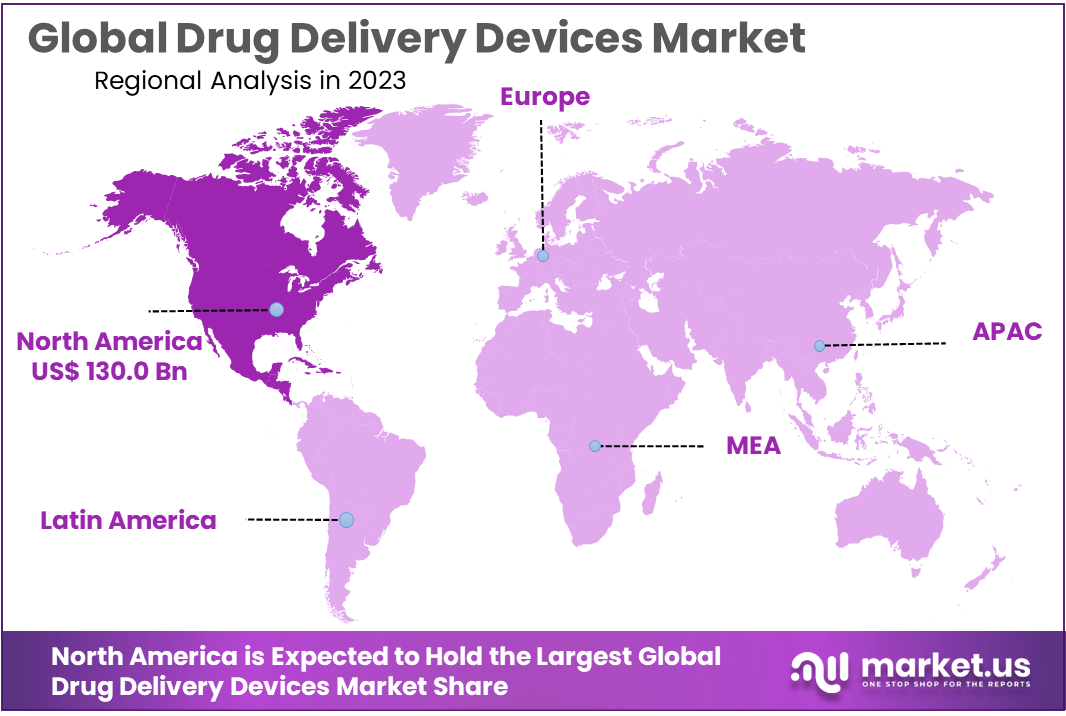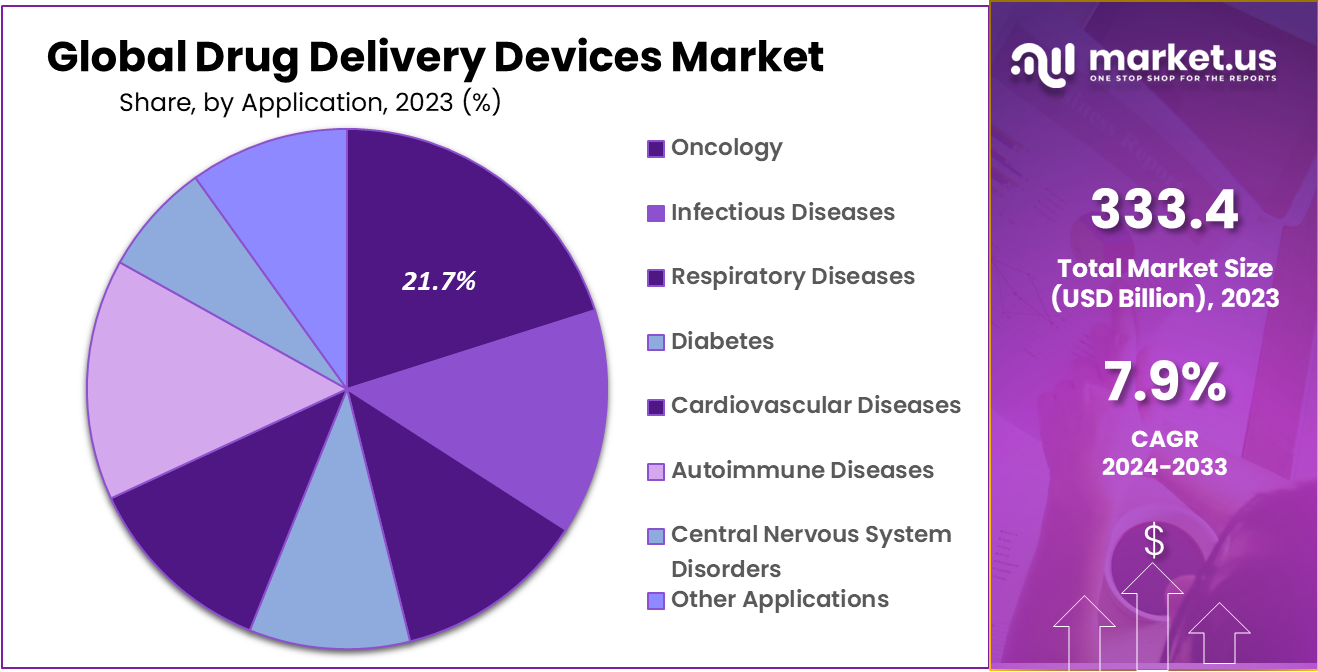New York, Feb. 07, 2024 (GLOBE NEWSWIRE) -- According to Market.us, the global Drug Delivery Devices Market size is forecasted to exceed USD 713.1 Billion by 2033, with a promising CAGR of 7.9% from 2024 to 2033.
Drug delivery devices differ from traditional drugs in that they offer a superior capability to precisely administer medications within the body. This enhances the efficacy of treatments for patients. The field of drug delivery is rapidly expanding, with a growing understanding of these innovative technologies. Governments are actively supporting these advancements, and companies are investing in the development of improved methods for delivering medicines.
The growth of the market will be propelled by the increasing adoption of advanced technology to efficiently transport drugs to specific locations in the body. These devices optimize the drug's presence at the intended site, thereby minimizing the risk of side effects. This optimization allows for a reduction in both side effects and dosage, ultimately contributing to a decrease in the overall cost of the product by lowering the amount of active pharmaceutical ingredients.
To understand Geography Trends, Download Sample Report Here: https://market.us/report/drug-delivery-devices-market/request-sample/

Key Takeaway:
- By route of administration, the market is divided into oral and parenteral, with the oral route emerging as the dominant segment in 2023. The oral segment claimed a market share of 38%.
- Based on application, the segments observed in the market are oncology, infectious disease, respiratory diseases, diabetes, cardiovascular diseases, autoimmune diseases, CNS disorders and others. Among these, oncology generated the most revenue for the market, with its market share reaching 21.7%.
- As far as vehicles for the drug delivery are concerned, the market is segmented into hydrogel, micelle, dendrimer nanoparticle, liposome, scaffold, mesoporous material and niosomes. Liposomes remained the largest contributing segment by securing a market share of 31.6%
- When classified by end-users, the segments observed in the market are hospitals, diagnostic centers, ambulatory surgical centers, home care settings and others. Out of these, hospitals contributed the most to the market with its market share reaching 31.8%.
- Region wise, North America secured the largest market share for the market, amassing 39% of market share.
Factors affecting the growth of the Drug Delivery Devices market:
- Increasing prevalence of chronic diseases has forced pharmaceutical businesses to seek for more effective solutions. This, in turn, has fueled the demand for drug delivery devices, thus accelerating market growth.
- The market for drug delivery devices is regulated by stringent and tedious regulatory measures. In addition to that, the introduction of any drug delivery devices is preceded by a plethora of approval processes. This ultimately has a negative influence on the growth of the market.
- Further, the new developments in the market have led to a new, unexplored avenue of personalized medicine. This particular field presents the market with a multitude of opportunities, which effectively aid in the process of market growth.
- Issues regarding pricing and reimbursement have been challenging for the process of market growth.
Top Trends in the Global Drug Delivery Devices Market:
- The drug delivery systems market is witnessing a trend towards personalized medicine, tailoring treatments based on individual patient characteristics. This includes the development of targeted drug delivery systems that enhance efficacy and minimize side effects.
- Advancements in biologics and nanotechnology are influencing drug delivery system design. Nanoparticle-based delivery systems and biocompatible materials are being explored for their potential in targeted and controlled drug release.
- The market is shifting towards user-friendly drug delivery devices to improve patient adherence. This includes the development of wearable devices, auto-injectors, and patch-based delivery systems that enhance convenience and compliance.
- There is a growing emphasis on eco-friendly and sustainable packaging solutions for drug delivery systems. Manufacturers are exploring recyclable and biodegradable materials to align with global sustainability goals.
- Evolving regulatory frameworks are shaping the market, with a focus on streamlining approvals for novel drug delivery technologies. Regulatory bodies are adapting to accommodate the fast-paced innovation in this sector.
- Strategic collaborations and partnerships between pharmaceutical companies, technology firms, and research institutions are fostering innovation. These alliances aim to combine expertise and resources to accelerate the development of novel drug delivery systems.
Market Growth:
The drug delivery systems market is poised for robust growth driven by innovative advancements and notable product launches. In January 2023, Abbott's introduction of FreeStyle Libre 3, featuring an upgraded continuous glucose monitoring (CGM) system, offers enhanced convenience and accuracy for diabetes management. Pfizer's FDA approval for Vyndaqel in June 2023, specifically addressing transthyretin amyloidosis, signifies significant progress in treating this condition.
Another milestone was achieved in August 2023 with the FDA's approval of the Omnipod 5, the first refillable wearable insulin pump system available exclusively through CVS pharmacies. This system facilitates remote monitoring and insulin control through a smartphone app, revolutionizing diabetes care. These technological breakthroughs, coupled with strategic alliances among market players, are expected to propel the drug delivery systems market, providing more efficient and patient-friendly solutions for various medical needs.
Macroeconomic Factors:
The drug delivery systems market is substantially influenced by macroeconomic factors that shape its growth trajectory. Economic indicators, such as GDP and healthcare expenditure, play pivotal roles in determining the market's performance. A robust economy often correlates with increased healthcare spending, fostering innovation and adoption of advanced drug delivery technologies. Regulatory policies and healthcare reforms impact market dynamics, influencing product approvals and market accessibility.
Additionally, demographic trends, including an aging population and changing disease patterns, contribute to the market's evolution. Trade policies and global economic conditions can affect the availability of raw materials and impact manufacturing costs. Moreover, currency exchange rates and inflation rates can influence pricing strategies and overall market competitiveness. The drug delivery systems market is intricately connected to macroeconomic variables, making it imperative for stakeholders to closely monitor and adapt to economic trends for sustainable growth.
Regional Analysis:
In 2023, North America commanded the largest market share at 39%, attributed to the presence of key industry players and a growing acceptance of drug delivery systems. The region's market expansion is anticipated to be further fueled by heightened awareness of the advantages offered by drug delivery systems, along with an increase in product approvals, exemplified by Aptar Pharma obtaining FDA approval for its nasal drug delivery system in the U.S.
Europe held a significant market share in 2023 and is expected to exhibit moderate growth. Major players in the region benefit from expansive markets facilitated by developed economies and favorable regulatory frameworks. The Asia Pacific region is poised for the highest growth rate, driven by robust economic expansion. The substantial patient base in countries like India, China, Japan, and others contributes to a surge in the adoption of drug delivery technology among various end-users. Japan, for instance, utilizes diverse drug delivery devices tailored for specific drug types.
Uncover the actionable insights tailored for your business strategy. Request our brochure to learn more https://market.us/report/drug-delivery-devices-market/#inquiry

Scope of the Report
| Report Attributes | Details |
| Market Value (2023) | USD 333.4 Billion |
| Forecast Revenue 2033 | USD 713.1 Billion |
| CAGR (2024 to 2033) | 7.9% |
| North America Share | 39% |
| Base Year | 2023 |
| Historic Period | 2018 to 2022 |
| Forecast Year | 2024 to 2033 |
Market Drivers
The growth of the drug delivery devices market is fueled by various factors, one significant driver being the escalating prevalence of chronic diseases. The increasing rates of chronic conditions, coupled with an aging population, technological advancements, and expanding healthcare expenditure, contribute to the market's expansion. As conditions such as cancer, diabetes, and cardiovascular diseases become more prevalent, there is a heightened demand for efficient drug delivery solutions.
Drug delivery devices offer a convenient and effective means of administering long-term treatments, addressing the evolving healthcare needs associated with the rising incidence of these diseases.
Market Restraints
Drug delivery devices encounter multiple challenges in achieving market success, including elevated expenses in development and manufacturing, rigorous regulatory demands, concerns related to patient compliance, and competition from established delivery methods. The substantial investments required for research, development, and manufacturing contribute to increased production costs and market entry expenses for drug delivery devices. Regulatory bodies, exemplified by the FDA, conduct thorough assessments before approving new products for market entry, resulting in prolonged timelines for introduction and impeding the prompt adoption of innovative devices by patients.
Market Opportunities
Advancements in biologics and personalized medicine present favorable prospects for manufacturers of drug delivery devices, particularly those offering innovative technologies suitable for intricate therapies requiring specialized delivery methods. Despite the potential for breakthrough innovations and lucrative revenue in these promising markets, the realization of such advancements may be impeded by challenges related to pricing and reimbursement issues.
In essence, while opportunities abound for drug delivery device makers in the realms of biologics and personalized medicine, addressing pricing and reimbursement concerns is crucial for the successful realization of breakthrough technologies in these fields.
Report Segmentation of the Drug Delivery Devices Market
Route of Administration Insight
In 2023, the Oral Route of Administration dominated the drug delivery market with a significant 38% market share, underscoring the widespread preference for oral drug delivery methods. The pharmaceutical industry is actively working towards enhancing the precision and efficiency of drug delivery, aiming to target specific areas in the body. The market segmentation by route of administration includes oral, intradermal, transdermal, and injectable, with the oral route claiming the largest share in 2023 and expected to maintain rapid growth.
Various dosage options for oral drug delivery, such as solutions, capsules, syrups, tablets, and suspensions, including tablets and films, contribute to its popularity due to safety, simplicity, cost-effectiveness, and stability. Inhalation drug delivery systems are favored for patients with pulmonary conditions like asthma or COPD. The injectable route is anticipated to experience the fastest growth, driven by increasing demand for injectable drugs facilitated by innovations like pen injectors and prefilled syringes. Market expansion is further propelled by advancements in inhalation delivery devices and the rising prevalence of respiratory diseases, with polymers and inert materials enhancing syringe technology.
Application Insight
In 2023, the drug delivery market was segmented into oncology, infectious disease, respiratory diseases, diabetes, endocrine disorders, and ophthalmic conditions. The largest market share was attributed to diabetes treatment devices, reflecting the growing prevalence of diabetes and the resultant increased adoption of diabetes drug delivery devices. Oncology held a substantial 21.7% share, emphasizing a significant focus on cancer treatment in drug delivery efforts.
The oncology segment, driven by the global rise in cancer cases, is expected to grow moderately. Liposomal and albumin drug delivery devices are prominently used in oncology. Central Nervous System Disorders (CNS) is projected to experience the fastest growth, fueled by the increasing incidence of neurological disorders like Parkinson’s, Alzheimer’s, and brain tumors. Innovative drug delivery systems for the CNS, employing receptor-ligand interaction and rational drug design, aim to enhance treatment effectiveness at neurological sites. Overall, these trends underscore the dynamic landscape of drug delivery applications, responding to prevalent health challenges.
Access Now for Quick Delivery | Buy Our Premium Research Report https://market.us/purchase-report/?report_id=19228
Vehicle Insight
In 2023, the drug delivery market showcased a variety of vehicles, with liposomes emerging as the most popular due to their non-immunogenic and biodegradable nature. Hydrogels, characterized by porosity and compatibility with aqueous environments, claimed a substantial market share, offering versatility in molding into various forms like microparticles and films. Their sustained drug delivery capability fueled growth, primarily driven by controlled drug release. The forecasted period anticipates the fastest growth in nanoparticle drug delivery devices, with a surge in research and interest.
Nanoparticles, particularly polymeric ones with hydrophilic and hydrophobic blocks, hold promise for encapsulating diverse drugs, including macromolecules like proteins and nucleic acids. This period is expected to witness a significant rise in the adoption and development of nanoparticle drug delivery systems.
End-User Insight
The Drug Delivery Devices Market, categorized by end-users in 2023, encompassed hospitals, diagnostic centers, ambulatory surgery clinics, home care settings, research centers, institutes, universities, and others. Hospitals dominated with a 31.8% share, driven by the rising incidence of neurological disorders and cancer. However, concerns about hospital-acquired infections may impact device adoption and potentially hinder segment growth in the forecast period.
Diagnostic centers also held a significant market share, emphasizing their focus on developing and adopting novel drug delivery methods. Research centers like the Center for Drug Delivery and Nanomedicine played a pivotal role in advancing drug delivery technologies. The home care setting segment is expected to experience the fastest growth due to factors such as increasing hospital-acquired illnesses, high costs, and longer wait times, fostering a shift toward self-administration and more treatments in home care settings. This trend signals a notable transition in drug delivery preferences from traditional hospital settings to more patient-centric home care.
Recent Development of the Drug Delivery Devices Market:
- In January 2023, Abbott launched the FreeStyle Libre 3, an advanced continuous glucose monitoring (CGM) system designed to offer individuals with diabetes a more convenient and precise method for monitoring blood glucose levels. The upgraded sensor and extended 14-day wear time enhance the effectiveness of glucose monitoring.
- In June 2023, Pfizer obtained FDA approval for Vyndaqel, an oral therapy specifically developed for transthyretin amyloidosis (ATTR). Vyndaqel aims to stabilize the transthyretin protein, preventing its aggregation into amyloid deposits that can cause damage to organs and tissues associated with ATTR.
- In August 2023, the FDA approved the first refillable wearable insulin pump system, the Omnipod 5. Exclusively available through CVS pharmacies, this insulin pump system enables patients to remotely monitor and control insulin usage via a smartphone app, offering unprecedented convenience in diabetes management. This refillable device represents a significant advancement in diabetes care.

Market Segmentation:
Route of Administration
- Oral
- Inhalation
- Parenteral
- Ocular
- Topical
- Other Routes of Administration
Application
- Oncology
- Infectious Diseases
- Respiratory Diseases
- Diabetes
- Cardiovascular Diseases
- Autoimmune Diseases
- Central Nervous System Disorders
- Other Applications
Vehicle
- Hydrogel
- Micelle
- Dendrimer
- Nanoparticle
- Liposome
- Scaffold
- Mesoporous Material
- Niosomes
End-use
- Diagnostic Centers
- Hospital
- Ambulatory Surgery Centers/Clinics
- Home Care Settings
- Other End-Uses
Get PDF For More Professional And Technical Insights @ https://market.us/report/drug-delivery-devices-market/request-sample/
By Geography
North America
- US
- Canada
Europe
- Germany
- France
- The UK
- Spain
- Italy
- Russia
- Netherland
- Rest of Europe
Asia Pacific
- China
- Japan
- South Korea
- India
- New Zealand
- Singapore
- Thailand
- Vietnam
- Rest of APAC
Latin America
- Brazil
- Mexico
- Rest of Latin America
Middle East & Africa
- South Africa
- Saudi Arabia
- UAE
- Rest of MEA
Competitive Landscape:
Industry participants are increasingly engaging in strategic partnerships to broaden their product offerings. Notably, DelSiTech and Bayer entered into a technology licensing agreement, collaborating on the development and promotion of cutting-edge delivery technology in the field of ophthalmology. Similarly, SMC Ltd. bolstered its product portfolio by acquiring Oval Medical Technologies Ltd., gaining access to their advanced auto-injectors. This trend of forming alliances for the advancement of drug delivery devices is poised to contribute to market growth.
Market Key Players
- Pfizer, Inc.s
- Hoffmann-La Roche Ltd
- Johnson and Johnson Private Ltd
- Novartis AG
- Teleflex Medical
- Bayer AG
- Becton, Dickinson and Company
- Baxter
- Abbott
- Other Key Players
About Us:
Market.US (Powered by Prudour Pvt Ltd) specializes in in-depth market research and analysis and has been proving its mettle as a consulting and customized market research company, apart from being a much sought-after syndicated market research report-providing firm. Market.US provides customization to suit any specific or unique requirement and tailor-makes reports as per request. We go beyond boundaries to take analytics, analysis, study, and outlook to newer heights and broader horizons.
Follow Us on LinkedIn
Our Blog:
